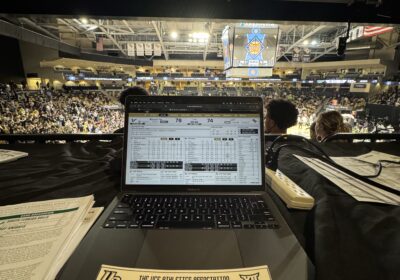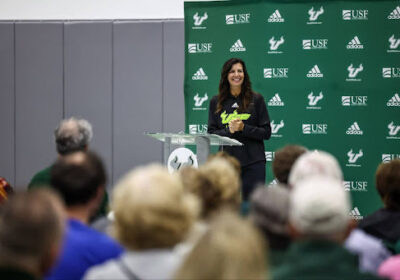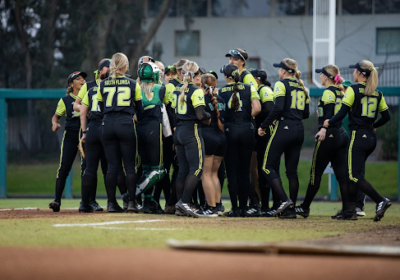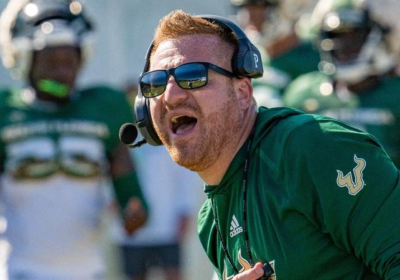The ‘dog’ days are over for AAC

UConn is on its way out of the AAC. ORACLE PHOTO/BRIAN HATTAB
There will soon be one less familiar face in USF's conference.
That’s because UConn is leaving the AAC in favor of “returning” to the Big East, though the earliest the move will happen is July 1, 2020.
Of course, saying UConn will be “returning” to the current Big East, as many have since the news broke, isn’t entirely accurate. The conference known as the Big East was formed in 2013 following a split from the original Big East (today’s AAC). It simply purchased the rights to the Big East name.
But the message is still clear — the Huskies want to be back with their old rivals — such as Georgetown, St. John’s and Providence College — more than they want to be with USF, UCF and Houston.
The plan has already been approved by the conference and an invitation was extended to UConn by the Big East’s presidents Monday, according to a report by CBS Sports. The move to the Big East would apply to all sports except football, which the Big East does not sponsor.
A formal announcement is expected at Madison Square Garden on Thursday.
The news, first reported over the weekend by Digital Sports Desk, which bills itself as “the online destination for Boston sports fans,” and later picked up by Stadium, was hardly denied by UConn, which stated “we have been and remain proud members of the American Athletic Conference.”
UConn and the AAC had always been an odd pairing anyway.
It’s clear UConn views itself as a basketball-first school, and with good reason — its basketball programs have won a combined 15 national championships — but the AAC is very much football minded in its ways. When the original Big East split up earlier this decade, it was done along football lines, after all. Football-playing members remained in the AAC, non-football (or, at least non-FBS) members went to the new Big East.
Considering the lack of the sport in UConn’s new home, it’s unclear where the football program will wind up. But it doesn’t seem likely to remain in the AAC, as various reports have claimed the conference does not want a football-only UConn due to, among other things, poor performance.
In fact, a source told Stadium that UConn was “delusional” for thinking it could continue to play football in the AAC after leaving for the Big East in other sports.
Conference USA and the MAC reportedly do not want UConn either, meaning the Huskies likely become an FBS Independent, which, outside of Notre Dame and BYU, usually means a program is left to wander in relative obscurity.
So what does the departure of a charter member of the conference — whether you consider that date to be 1979 or 2013 — mean for the AAC and for USF?
Football: Na Na Na Na, Hey Hey Hey…
No one in the AAC is going to be sorry to see UConn’s football program leave.
The Tampa Bay Times called it an “albatross of sorts for the AAC” over the weekend, and that may be putting it kindly.
Since making the 2010 Fiesta Bowl, the Huskies have been bowl eligible one time — a 6-6 2015 regular season that ended in a loss in the St. Petersburg Bowl. Worse yet, UConn’s record since 2013 is 18-55.
While teams are always going to have ups and downs, UConn’s consistently terrible performances were hurting the AAC’s “Power 6” brand. Similarly, teams that played UConn — especially teams in the AAC East like USF, who played UConn annually — were suffering massive hits to their strength of schedule, making it harder to make a case of a place in the College Football Playoff.
If the AAC adds a school to replace UConn — and it’s hardly a guarantee it will — it’ll almost assuredly be an improvement from a competitive standpoint.
Basketball: Kind of hurts, but on the bright side…
Losing UConn’s basketball programs is unfortunate for the AAC.
UConn is a valuable brand in basketball and has the hardware to back it up. The men’s team in 2014 and women’s team in 2014, 2015 and 2016 are the AAC’s only national championships since it split from the Big East.
Recency bias will make some say that UConn’s men’s team hasn’t done much for the AAC since that national championship, though. But it’s too small an amount of time to say that versus how strong the brand has been perceived to be historically.
It’s a mixed bag for USF when it comes to women’s basketball. On one hand, without UConn in its way, it’ll actually be able to compete for a conference championship for the first time in program history starting in 2021.
On the other hand, as mentioned in the same Tampa Bay Times article as above, the AAC’s RPI was No. 9 in the nation last season — just slightly better than the Colonial Athletic Conference. That’s with the Huskies. It’s hard to imagine it improving when they leave.
So now what?
UConn will likely formally accept the Big East’s offer as early as Wednesday, per multiple reports. What it’ll have to pay the AAC to get out and the Big East to get in is to be determined, but it’s unlikely this change will come cheap.
The obvious question for the AAC is who it replaces UConn with — if any replacement is made at all. It may have to, though, as Sports Business Journal reported that UConn’s departure triggers the ability for ESPN to renegotiate its new $1 billion media contract with the AAC. Replacing UConn could be a way to appease ESPN and prevent a renegotiation.
The conference could offer Navy full membership. However, it’s unknown if the Midshipmen would want to leave the Patriot League where its rival Army is. It’s unlikely Navy would do much to bolster basketball anyway.
It could offer Army a football-only membership in a similar setup to Navy. But that would likely mean having to move the iconic Army-Navy game to before conference championship weekend, which would basically be sacrilege.
The AAC could poach a full member from Conference USA. Once UConn leaves, with the exception of Temple and Navy, every football member in the AAC will have come directly from Conference USA. UAB could be an interesting add. Charlotte could be too.
But even those schools, in large markets, have their drawbacks. UAB perpetually lives in the shadow of that school in Tuscaloosa. So does Charlotte with North Carolina and Duke. Plus, would ECU be willing to add another conference team in North Carolina?
There’s probably no easy solution to replacing UConn and the Huskies aren’t making it any easier by giving the AAC what could wind up being relatively short notice of their intent to leave.
The next year for the AAC could be an interesting one.






